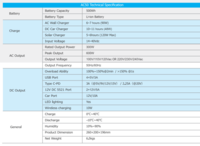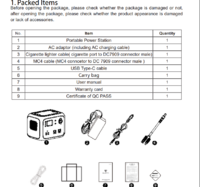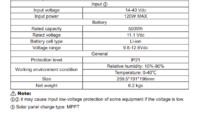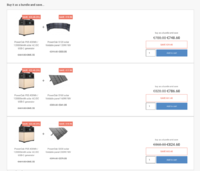You are using an out of date browser. It may not display this or other websites correctly.
You should upgrade or use an alternative browser.
You should upgrade or use an alternative browser.
Can I use a DC to DC charger to provide higher voltages to DC charger? (aka using an all-in-one solar generator in a van install)
- Thread starter Andysmee
- Start date
EU version in Grey:
 www.solarpowersupply.co.uk
www.solarpowersupply.co.uk

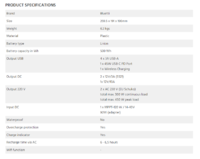
Bluetti AC50 500Wh/300W Power Station
You can order the Bluetti AC50 500Wh/300W Power Station at Solar Power Supply ➤ A complete assortment ➤ Expert Tips/Advice


I think this reflects what we are finding, that the voltage you present affects the charging detection and it makes decisions about what it can pull, as it's a combined DC and MPPT input.- There is actually an MPPT controller installed as it is in the instructions, but what I don't understand: I connected my solar panels in series, but only had half the power as a result? So about 25W. Connected in parallel they brought 50W. I am a trained electronics technician and know that the performance should NOT change, only the voltage / current ratio.
My remaining query on this is what happens if you use a solar panel that offers more than the 120W? Will it error and shut down charging or regulate the input and retain the maximum it can?
Looks like the bigger pack comes with a beefier AC PSU - 90W. No reason not to use a bigger supply on the smaller one? Or even a 120W, by rights?
In which case, since this is my thread  what rooftop solar panel should I spec to provide 100W+ on a English spring or autumn day?
what rooftop solar panel should I spec to provide 100W+ on a English spring or autumn day?
I have, and will read the solar panel threads, so it's more the power / size to offer that, not the model
I have, and will read the solar panel threads, so it's more the power / size to offer that, not the model
Last edited:
I bought the 120W PowerOak fold out panel for the PS6S, I got bored of looking and just bought their package!! I didn't want anything on my van roof as mine is a work van with occasional camper use. Looking at the PowerOak site the minimum spec solar panel they sell as a package with the PS5 is 120W going up to 200W. Maybe go middle of the road 160W. Can you buy specific panels for roof mounting on vehicles ?
Time to split off to the main threads on this...
-- Dellmassive`s -- "How I Done It" -- ...
*****************************************************
SOLAR:
- Solar Pwm & Mppt Controllers - How I Done It -
- Mobile Solar Panels ? . . . - How I Did It -
- What Solar Panel & Controller? - How We Done It -
- Solar Panel Cutting Hole In Roof !!! - How We Done It -
- 300w Plus Solar Club -- How I Done It --
- Solar Sheds & Other Non-t6 Solar Projects - How We Done It -
*****************************************************
Except for my question
i show a various collection of panels connected to the ALLPOWERS over here:
1st test.
Lensun 110W panel VOC @ 21.24V
not ideal sun but its taking it in. (upto 60W max i think)
tested VOC with a Multimeter and had 21.9v in full sun.
just saw 52W in . . .
**
Solar test #2
Renogy Foldable 100W (just the bair panel direct to ALLPOWERS - not using panels own controller)
[email protected]
[email protected]
**
Solar test #3
Renogy suitcase 100W (just the bare panel direct to ALLPOWERS - not using panels own controller)
[email protected]
[email protected] (6A)
**
Solar test #4
ACCOPOWER 50W (just the bare panel direct to ALLPOWERS - not using panels own controller)
[email protected]
[email protected] (3.04A)
**
Solar test #5
Lesnun 220W (2x 110w in parallel0
(just the bair panel direct to ALLPOWERS - not using panels own controller)
[email protected]
[email protected] (6.72A + 6.72A )
**
compressor fridge test:
**
3way absorption fridge test:

 www.t6forum.com
www.t6forum.com
**
camping test:
**
storage bags:
**
camping test #2
**
1st test.
Lensun 110W panel VOC @ 21.24V
not ideal sun but its taking it in. (upto 60W max i think)
tested VOC with a Multimeter and had 21.9v in full sun.
just saw 52W in . . .
**
Solar test #2
Renogy Foldable 100W (just the bair panel direct to ALLPOWERS - not using panels own controller)
[email protected]
[email protected]
**
Solar test #3
Renogy suitcase 100W (just the bare panel direct to ALLPOWERS - not using panels own controller)
[email protected]
[email protected] (6A)
**
Solar test #4
ACCOPOWER 50W (just the bare panel direct to ALLPOWERS - not using panels own controller)
[email protected]
[email protected] (3.04A)
**
Solar test #5
Lesnun 220W (2x 110w in parallel0
(just the bair panel direct to ALLPOWERS - not using panels own controller)
[email protected]
[email protected] (6.72A + 6.72A )
**
compressor fridge test:
**
3way absorption fridge test:

Awesome 3-in-1 Battery Bank - How I done It -
Liking this, Could charge my power chair batteries while out and about (using the 3 pin plug on the battery)
**
camping test:
**
storage bags:
**
camping test #2
**
this might be worth a look too . .
Bluetti AC200 - Solar Charging in February
.
Bluetti AC200 - Solar Charging in February
.
Only £2100!this might be worth a look too . .
Bluetti AC200 - Solar Charging in February
.
So..... Resuming this thread, but with a twist..That ain't a problem if it's on the roof, that's the direction I'm going
Having decided that the only sensible way to charge this pack is solar, I now find that a 24V system might be useful for making the most of the 300W available from the inverter.
This is because 24V appliances tend to offer useful outcomes in the 100-300W range (24V 250W kettle for ~£15 boils 0.5l in <15 mins) where 12V appliances tend to offer terrible outcomes in the 0-150W range (same kettle above can only pull 150W and takes 25mins).
Of course, a 240V kettle can pull 2-3kW and boil like at home.
So, what to do?
1. Go with the original plan A and get a 12V to 24V DC-DC converter running off the alternator. Can charge the leisure battery quickly when the engine's running and open up the possibility of 24V appliances using the engine as a generator. Easy to mount the DC-DC next to the battery and bring in a big 24V cable into the van. Have to run the engine to use 24V/ high power. £
2. Go with a bigger separate inverter and run the original AC battery charger that came with the battery pack as well as 240V appliances when the engine's running. Easy to switch to EHU when available. Downside is taking me straight back into classic underseat build and additional expense which I had avoided. £££
3. Get a 240V to 24V PSU which could offer up the full 300W from the built in inverter on the battery pack to 24V appliances. Leave the charging to solar or EHU when available. Remain limited to 300W but have useful appliances. ££
4. Put a 12V to 24V DC-DC converter as charging circuit from the alternator, or just rely on solar entirely for charging, whilst adding a new bigger inverter wired to the battery pack's lithium cells directly (jump-start lead output). I don't think the battery pack regulates this output, so it would need additional protection but would remove the 300W limit. ££
This is why these packs are not yet 100% the answer if you are a high power user, which I wasn't when the thread started! I think I know the answer after thinking out loud - heat water with gas?
Last edited:
Similar threads
- Replies
- 20
- Views
- 3K
- Replies
- 16
- Views
- 2K
- Replies
- 1
- Views
- 175
- Replies
- 66
- Views
- 9K

